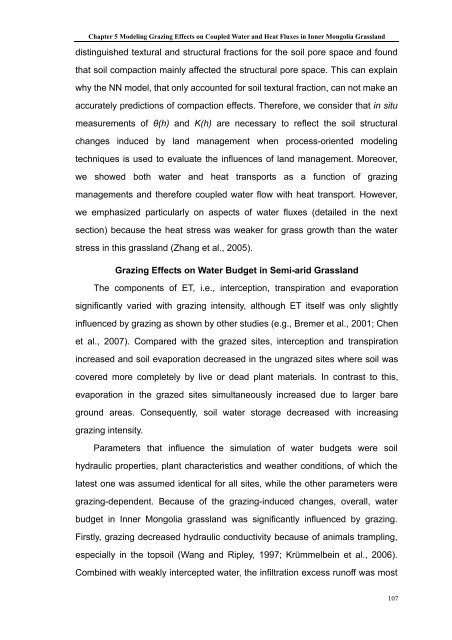SCHRIFTENREIHE Institut für Pflanzenernährung und Bodenkunde ...
SCHRIFTENREIHE Institut für Pflanzenernährung und Bodenkunde ...
SCHRIFTENREIHE Institut für Pflanzenernährung und Bodenkunde ...
You also want an ePaper? Increase the reach of your titles
YUMPU automatically turns print PDFs into web optimized ePapers that Google loves.
Chapter 5 Modeling Grazing Effects on Coupled Water and Heat Fluxes in Inner Mongolia Grassland<br />
distinguished textural and structural fractions for the soil pore space and fo<strong>und</strong><br />
that soil compaction mainly affected the structural pore space. This can explain<br />
why the NN model, that only accounted for soil textural fraction, can not make an<br />
accurately predictions of compaction effects. Therefore, we consider that in situ<br />
measurements of θ(h) and K(h) are necessary to reflect the soil structural<br />
changes induced by land management when process-oriented modeling<br />
techniques is used to evaluate the influences of land management. Moreover,<br />
we showed both water and heat transports as a function of grazing<br />
managements and therefore coupled water flow with heat transport. However,<br />
we emphasized particularly on aspects of water fluxes (detailed in the next<br />
section) because the heat stress was weaker for grass growth than the water<br />
stress in this grassland (Zhang et al., 2005).<br />
Grazing Effects on Water Budget in Semi-arid Grassland<br />
The components of ET, i.e., interception, transpiration and evaporation<br />
significantly varied with grazing intensity, although ET itself was only slightly<br />
influenced by grazing as shown by other studies (e.g., Bremer et al., 2001; Chen<br />
et al., 2007). Compared with the grazed sites, interception and transpiration<br />
increased and soil evaporation decreased in the ungrazed sites where soil was<br />
covered more completely by live or dead plant materials. In contrast to this,<br />
evaporation in the grazed sites simultaneously increased due to larger bare<br />
gro<strong>und</strong> areas. Consequently, soil water storage decreased with increasing<br />
grazing intensity.<br />
Parameters that influence the simulation of water budgets were soil<br />
hydraulic properties, plant characteristics and weather conditions, of which the<br />
latest one was assumed identical for all sites, while the other parameters were<br />
grazing-dependent. Because of the grazing-induced changes, overall, water<br />
budget in Inner Mongolia grassland was significantly influenced by grazing.<br />
Firstly, grazing decreased hydraulic conductivity because of animals trampling,<br />
especially in the topsoil (Wang and Ripley, 1997; Krümmelbein et al., 2006).<br />
Combined with weakly intercepted water, the infiltration excess runoff was most<br />
107


